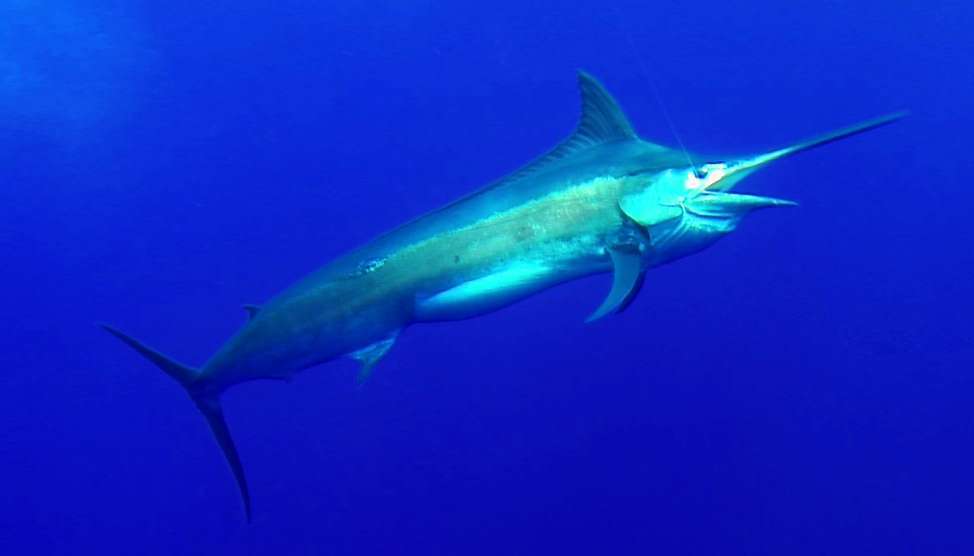Contact us if your target is Marlin in Costa Rica
See our Marlin Photo Gallery

Black Marlin
In the North Pacific coast it can be found every month of the year, especially from November to March. In the Central Pacific coast it is especially good from September to November. In the Southern zone the best season goes from August to December, black or blue Marlin are a favorite of fishermen. They are pelagic and migratory species, which means they live near the surface in deep and marine waters. They are usually found in warmer tropical waters between 70-85 degrees, which Costa Rica has year-round.
Marlin Facts:
- Marlins are “catch and release”, it is illegal to remove these fish from the water in Costa Rica
- The blue marlin is a very large fish. Females are 3 to 4 times larger than males. The largest samples can reach 14 feet in length and weight of almost 2000 pounds. On average, the blue needle usually reaches 11 feet in length and between 200 and 400 pounds in weight.
- The back of the blue marlin is dark blue while the belly is silver white. The blue marlin has an elongated body, long tail, pronounced dorsal fin and sharp, spear-shaped upper jaw.
- The blue needle uses its spear-shaped jaw to stun, pen and catch food. It feeds on crustaceans, fish (mackerel, tuna), dorado and squid.
- During the hunt, the blue marlin will pass through a dense school of fish and inflict wounds with its spear. Dead or injured fish will float around and the blue needle will easily pick them up later.
- The blue marlin relies on the view to find food. Hunting during the day.
- The blue needle has 24 vertebrae that allow rapid movement through water. Reach the speed of 60 miles per hour.
- Due to their large size and sharp jaw-shaped jaw, blue marlines have only a couple of natural predators: white sharks and mako sharks.
- Blue marlines are very active and strong animals. They like to jump out of the water. In addition, they will show powerful and acrobatic movements while trying to free the hook.
- Blue marlines are lonely creatures. Sometimes they swim in pairs. On rare occasions, they will meet in larger groups.
- Blue marlines are migratory species. They will move from one place to another to escape the low temperatures of the water (they prefer life in warm waters).
- It reaches up to 14 feet
More about the Pacific Blue Marlin
It is less abundant in the eastern portions of both oceans.
A Japanese report indicates that the blue marlin is the largest of the isthiopoid fish. Apparently it grows bigger in the Pacific. All giant marlins are female, and the male blue marlin rarely exceeds 300 pounds (136 kg). The pectoral fins of the blue needle are never completely rigid, even after death, and can be folded completely against the sides, except in larger specimens. The dorsal fin is high and pointed previously (instead of rounded) and its maximum height is less than the greater depth of the body. The anal fin is relatively large and is also pointed. Juveniles may not share all the features listed above, but the peculiar lateral line system is usually visible in small samples. In adults, it is rarely visible unless the scales or skin are removed. The vent is just in front of the anal fin, as in all marlines except the spearfish. The back is cobalt blue and the flanks and belly are silver white. There may be light blue or lavender vertical stripes on the sides, but they usually fade shortly after death, and are never as obvious as those on the striped needle. There are no spots on the fins.
They are known to feed on squid and pelagic fish, including tuna and mackerel. A powerful and aggressive fighter, runs hard and long, with a deep sound and jumps very high in the air in a show of seemingly inexhaustible strength. Fishing methods include the bait of large whole baits, such as bonito, dorado, mullets, mackerels, ballyhoo, flying fish and squid, as well as various types of artificial lures and, sometimes, baits.
Difference between Black Marlin and Blue Marlin
Being close, it can be quickly identified, since it is the only needle that has rigid pectoral fins that cannot be folded against the body without breaking the joints. It is also distinguished by the aerodynamic shape of the pectoral fins and their very short ventral fins, which almost never exceed 12 in (30 cm) in length, regardless of the size of the fish. The first dorsal fin is proportionately the lowest of all billfishes, generally less than 50 percent of the body’s depth. The body is compressed laterally, instead of rounded, much more than in the blue needle of similar size.



